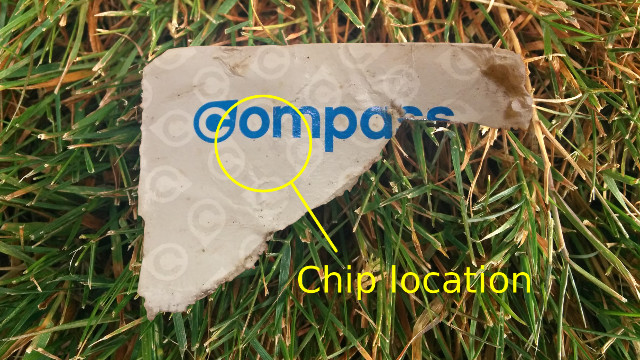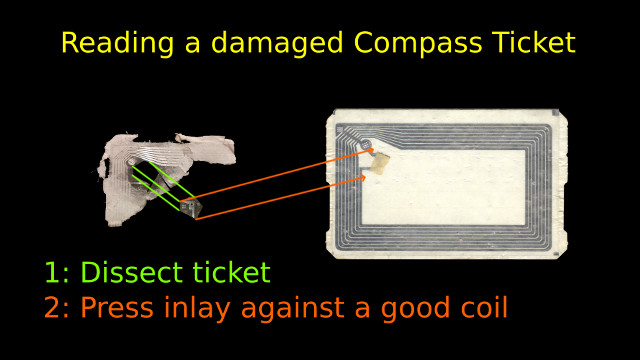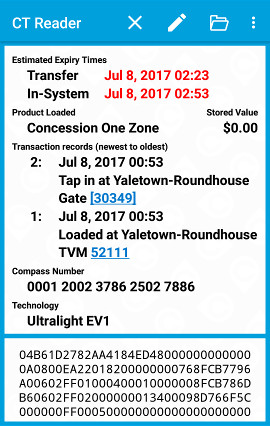
| HOME · MOVIES · HIKING · PHOTOS | SITE MAP | ||
If one walks through grassy parkland often enough, one will eventually come across litter that's been cut to shreds by a city lawn mower. Occasionally the fragments are from a TransLink Compass Ticket. Whole Compass Ticket litter is usually usable as a free NFC token but ticket fragments are almost useless; however, the data might still be readable if the silicon chip has not been damaged and is still attached to the plastic inlay.
Below is an image of a ticket that has been through a lawn mower. Curiously, this was the only fragment found. It's unknown what happened to the other pieces but the author isn't too worried about that mystery because this piece is the one with the chip. The location is indicated by the yellow circle; hold a ticket up to a bright light to see what's inside!

To test the chip's functionality, one first needs a good coil. One can be obtained by dissecting a whole ticket to remove the front card stock in order to expose the chip and coil, then removing the chip, and covering up the chip mounting pads with tape. The card stock on the reverse of the good coil shouldn't be removed because it adds stiffness to the assembly. Don't worry, no working tickets were sacrificed for this experiment, as plenty of tickets with a dead chip can be found in transit litter.
The Compass Ticket fragment should be dissected to cut out a small piece of the plastic inlay with the chip plus enough of the metallic contacts to make electrical contact with the good coil. First, remove the card stock from the front and back by soaking in water and rubbing off the paper, then clean residual cement from the contacts near the chip in order to allow for electrical contact with the good coil. Next, cut out a square centimetre of inlay with the chip and cleaned contacts. This piece is to be turned over and pressed against the good coil so that the electrical leads make contact while a smartphone with an NFC app is running, trying to read the assembled Frankenstein ticket.
Curiously, when using this technique in an attempt to read data from dead tickets found as litter on the street, only around 15% of them can be successfully read. It's not known if the chips are very easily damaged, or if their connection to the metallic contacts is easily broken and are damaged by the cleaning and dissection process. So be careful!

Any app designed to read an NFC token should be usable for this. The author used his CT Reader Android app to read and display the ticket data. Here's a screenshot of the result; the raw data bytes are shown at the bottom of the image. This ticket uses the MIFARE Ultralight EV1 chip, thus there are 80 bytes to read; older tickets use the deprecated Ultralight chip which has 64 bytes.

Oh, look! The user of this ticket tapped-in at Yaletown Station but never tapped-out. Naughty, naughty!
For details about most Compass Ticket internal data structures please see the Inside Compass Tickets page.
Copyright © 2017 Toomas Losin. All rights reserved. This document is released under the Creative Commons Attribution (CC BY) license.
| Copyright © 1996-2017 Toomas Losin | Contact | Disclaimer | ||